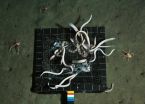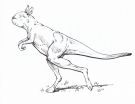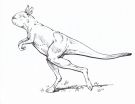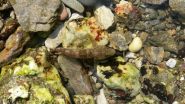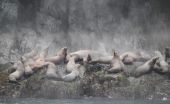Microfossils reveal warm oceans had less oxygen, Syracuse geologists say
Professor Zunli Lu uses geochemistry, micropaleontology to track oxygen levels in global oceans
2014-10-15
(Press-News.org) Researchers in Syracuse University's College of Arts and Sciences are pairing chemical analyses with micropaleontology—the study of tiny fossilized organisms—to better understand how global marine life was affected by a rapid warming event more than 55 million years ago.
Their findings are the subject of an article in the journal Paleoceanography (John Wiley & Sons, 2014).
"Global warming impacts marine life in complex ways, of which the loss of dissolved oxygen [a condition known as hypoxia] is a growing concern" says Zunli Lu, assistant professor of Earth sciences and a member of Syracuse's Water Science and Engineering Initiative. "Moreover, it's difficult to predict future deoxygenation that is induced by carbon emissions, without a good understanding of our geologic past."
Lu says this type of deoxygenation leads to larger and thicker oxygen minimum zones (OMZs) in the world's oceans. An OMZ is the layer of water in an ocean where oxygen saturation is at its lowest.
Much of Lu's work revolves around the Paleocene-Eocene Thermal Maximum (PETM), a well-studied analogue for modern climate warming. Documenting the expansion of OMZs during the PETM is difficult because of the lack of a sensitive, widely applicable indicator of dissolved oxygen.
To address the problem, Lu and his colleagues have begun working with iodate, a type of iodine that exists only in oxygenated waters. By analyzing the iodine-to-calcium ratios in microfossils, they are able to estimate the oxygen levels of ambient seawater, where microorganisms once lived.
Fossil skeletons of a group of protists known as foraminiferas have long been used for paleo-environmental reconstructions. Developing an oxygenation proxy for foraminifera is important to Lu because it could enable him study the extent of OMZs "in 3-D," since these popcorn-like organisms have been abundant in ancient and modern oceans.
"By comparing our fossil data with oxygen levels simulated in climate models, we think OMZs were much more prevalent 55 million years ago than they are today," he says, adding that OMZs likely expanded during the PETM. "Deoxygenation, along with warming and acidification, had a dramatic effect on marine life during the PETM, prompting mass extinction on the seafloor."
Lu thinks analytical facilities that combine climate modeling with micropaleontology will help scientists anticipate trends in ocean deoxygenation. Already, it's been reported that modern-day OMZs, such as ones in the Eastern Pacific Ocean, are beginning to expand. "They're natural laboratories for research," he says, regarding the interactions between oceanic oxygen levels and climate changes."
INFORMATION:
The article's lead author is Xiaoli Zhou, a Ph.D. student of Lu's in Syracuse's Earth sciences department. Other coauthors are Ellen Thomas, a senior research scientist in geology and geophysics at Yale University; Ros Rickaby, professor of biogeochemistry at the University of Oxford (U.K.); and Arne Winguth, assistant professor of oceanography at The University of Texas at Arlington.
Housed in Syracuse's College of Arts and Sciences, the Department of Earth Sciences offers graduate and undergraduate degree opportunities in environmental geology, wetland hydrogeology, crustal evolution, sedimentology, isotope geochemistry, paleobiology, paleolimnology, and global environmental change.
[Attachments] See images for this press release:

ELSE PRESS RELEASES FROM THIS DATE:
2014-10-15
A new study using a reconstruction of North American drought history over the last 1,000 years found that the drought of 1934 was the driest and most widespread of the last millennium.
Using a tree-ring-based drought record from the years 1000 to 2005 and modern records, scientists from NASA and Lamont-Doherty Earth Observatory found the 1934 drought was 30 percent more severe than the runner-up drought (in 1580) and extended across 71.6 percent of western North America. For comparison, the average extent of the 2012 drought was 59.7 percent.
"It was the worst by a ...
2014-10-15
This week, researchers from University of Hawai'i, Norway, and the UK have shown with innovative experiments that a rise in jellyfish blooms near the ocean's surface may lead to jellyfish falls that are rapidly consumed by voracious deep-sea scavengers. Previous anecdotal studies suggested that deep-sea animals might avoid dead jellyfish, causing dead jellyfish from blooms to accumulate and undergo slow degradation by microbes, depleting oxygen at the seafloor and depriving fish and invertebrate scavengers, including commercially exploited species, of food.
Globally ...
2014-10-15
PROVIDENCE, R.I. [Brown University] — Imagine that a time machine has transported you to the Australian outback 100,000 years ago. As you emerge, you see a huge kangaroo with a round rabbit-like face foraging in a tall bush nearby. The animal's surprising size makes you gasp aloud but when it hears you, becoming equally unnerved, it doesn't hop or lumber away on all fours and tail like every kangaroo you've seen in the present. It walks on its feet. One at a time. Like you.
In a new paper in the journal PLoS ONE, a team of researchers led by Christine Janis, professor ...
2014-10-15
Now extinct giant kangaroos most likely could not hop and used a more rigid body posture to move their hindlimbs one at a time, according to a study published October 15, 2014 in the open-access journal PLOS ONE by Christine Janis from Brown University and colleagues.
The "short-faced," large-bodied sthenurine kangaroos–a now extinct relative to modern-day kangaroos–first appeared in the middle Miocene and became extinct in the late Pleistocene. The largest of these kangaroos had an estimated body mass of 240 kg, almost three times the size of the largest ...
2014-10-15
Turning the street lights off decreased the number of grounded fledglings, according to a study published October 15, 2014 in the open-access journal PLOS ONE by Airam Rodríguez and colleagues from Phillip Island Nature Parks, in Victoria, Australia, and Estación Biológica de Doñana, in Spain.
Thousands of birds are attracted to lights–sometimes referred to as light-pollution–every year worldwide during their first flights from their nests to the open ocean, a phenomenon called 'fallout.' Short-tailed shearwater breeding on the coast of ...
2014-10-15
People who risk their lives to save strangers may do so without deliberation, according to an analysis of statements from more than 50 recognized civilian heroes, conducted by David Rand from Yale University and colleagues published October 15, 2014 in the open access journal PLOS ONE.
Scientists studying human cooperation recruited hundreds of participants to rate 51 statements made during published interviews by recipients of the Carnegie Hero Medal, given to civilians who risk their lives to save strangers. Study participants as well as a computer text analysis algorithm ...
2014-10-15
Research from the University of Exeter has revealed that the rock goby (Gobius paganellus), an unassuming little fish commonly found in rock pools around Britain, southern Europe, and North Africa, is a master of camouflage and can rapidly change colour to conceal itself against its background.
Whether hiding from predators or from families hunting in rock pools, the rock goby can change both its colour and brightness to match its background in just one minute.
Dr Martin Stevens from the Centre for Ecology and Conservation at the University of Exeter's Penryn Campus ...
2014-10-15
An investigation into how patient outcomes are assessed in clinical trials has revealed a worrying lack of consistency, raising concerns about funding being wasted on the acquisition of poor quality data.
Information collected through clinical trials plays a crucial role in improving the standard of patient care. Patient Reported Outcomes (PROs) inform our understanding of how certain treatments and interventions work by evaluating their effectiveness, and any potential side effects, from the patient perspective.
Patients in trials are commonly invited to fill in questionnaires ...
2014-10-15
NEWPORT, Ore. – Pacific sleeper sharks, a large, slow-moving species thought of as primarily a scavenger or predator of fish, may be preying on something a bit larger – protected Steller sea lions in the Gulf of Alaska.
A new study found the first indirect evidence that this cold-blooded shark that can grow to a length of more than 20 feet – longer than a great white shark – may be an opportunistic predator of juvenile Steller sea lions.
Results of the study have just been published in the journal Fishery Bulletin. The findings are important, ...
2014-10-15
Astronomers using the National Science Foundation's Green Bank Telescope (GBT) in West Virginia, along with data from other large radio telescopes, have discovered that our nearest galactic neighbors, the dwarf spheroidal galaxies, are devoid of star-forming gas, and that our Milky Way Galaxy is to blame.
These new radio observations, which are the highest sensitivity of their kind ever undertaken, reveal that within a well-defined boundary around our Galaxy, dwarf galaxies are completely devoid of hydrogen gas; beyond this point, dwarf galaxies are teeming with star-forming ...
LAST 30 PRESS RELEASES:
[Press-News.org] Microfossils reveal warm oceans had less oxygen, Syracuse geologists say
Professor Zunli Lu uses geochemistry, micropaleontology to track oxygen levels in global oceans

